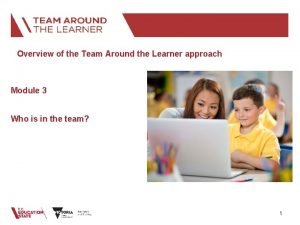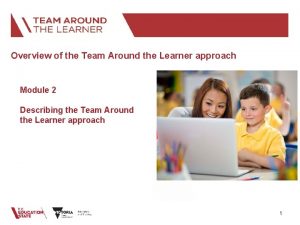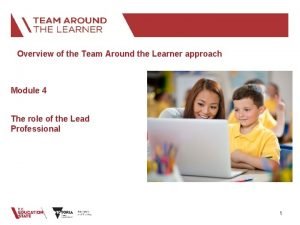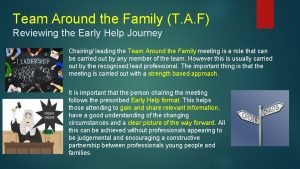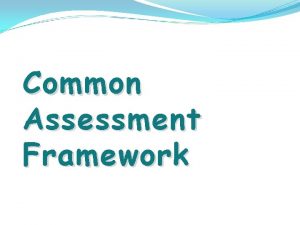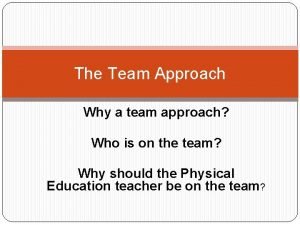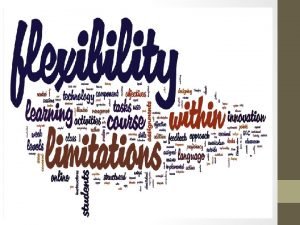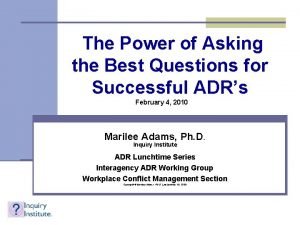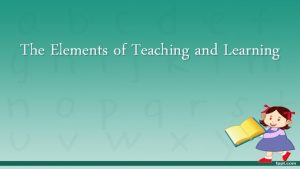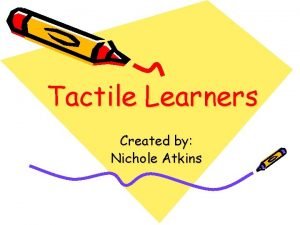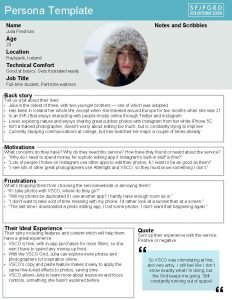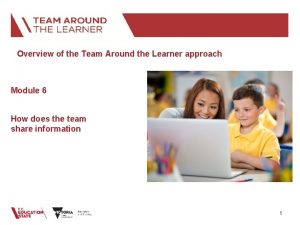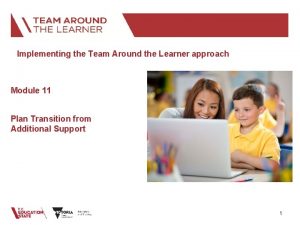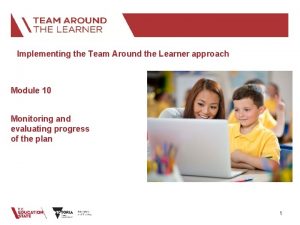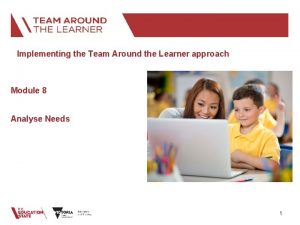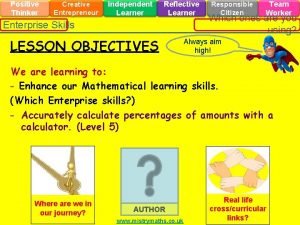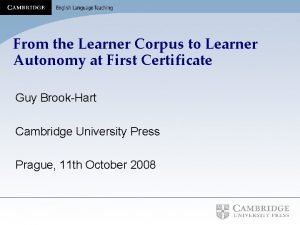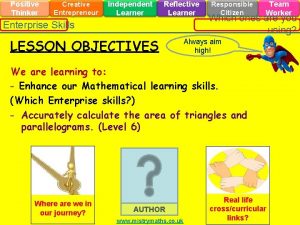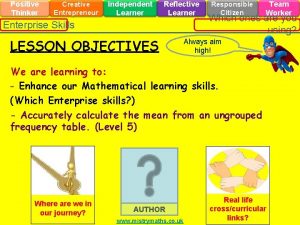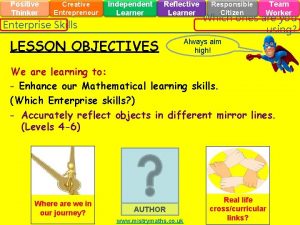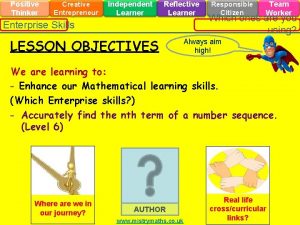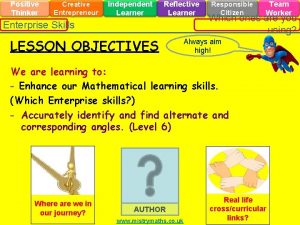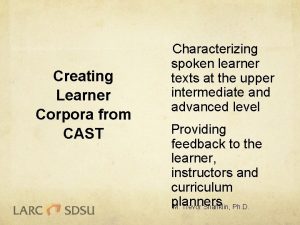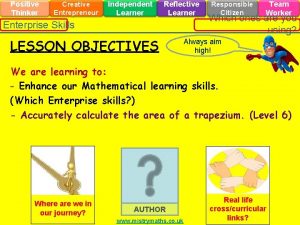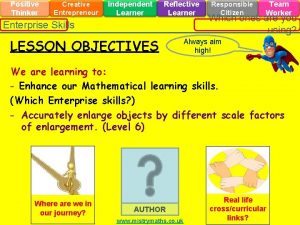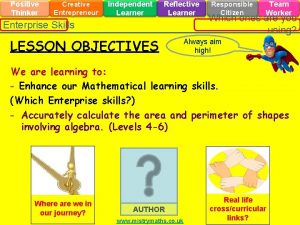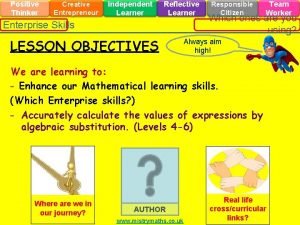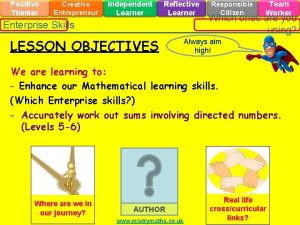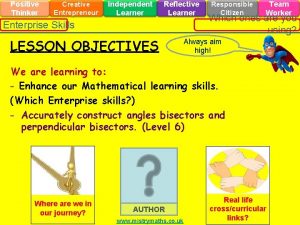Overview of the Team Around the Learner approach






























- Slides: 30

Overview of the Team Around the Learner approach Module 4 The role of the Lead Professional 1

Module 4: The role of the Lead Professional Overview The aim of this module is to help Lead Professionals identify and bring together the right team for a Team Around the Learner approach. The module also outlines how to work with different stakeholders and how to build, manage and maintain successful relationships. It supports the Lead Professional to facilitate effective Team Around the Learner meetings. Focus This module will support your understanding of: 4. How to lead a team of people to coordinate the work required to support a learner with complex needs Engaging the right team and bringing them together Building successful relationships to support a high functioning team Working with different stakeholders Organising meetings and facilitating effective discussion Leading a culture of feedback and growth Identifying the need to escalate team issues and asking for help 2

Engaging the right team and bringing them together Having the right team in place to support the learner and their family through the Team Around the Learner approach is important in creating successful and sustainable outcomes. • Teams are made up of people who have natural, community and formal support relationships with the learner. Examples of team members include health professionals, education professionals, external community agencies, other government departments, relatives, friends and community members who are connected to the learner. • As learners and their needs are different, the composition of the team and the skills required will vary for each learner. • Engagement of the learner and family in building the team is the best practice. • The Lead Professional should explain the Team Around the Learner approach to team members and the important roles they can play. • The team should ensure that learning engagement is a priority goal throughout the process. 3

Engaging the right team and bringing them together Identifying and communicating team involvement. A team approach Identifying and contacting Ascertaining engagement At different points in the Team Around the Learner approach, individuals will be identified and invited to join the learner's team. Contacting the team members may be undertaken by the Lead Professional on their own or with the learner and family. As team members are invited, their levels of engagement and willingness to participate as part of the team should be ascertained. The Lead Professional should ascertain each individual’s commitment to the approach. • The Team Around the Learner approach The learner should feel involved in the process and given the choice but should not feel as though it is all their responsibility. • What will be expected of them • How the Team Around the Learner approach will be conducted • Who will be involved in the Team Around the Learner • The time commitment involved Before joining the team, the Lead Professional should brief team members on: If there are team members who are less committed, the Lead Professional should explain further about the value of the process in the educational future of the learner. Others in the team may also be able to support reluctant team members by drawing on the connections that they have developed with these team members. 4

Engaging the right team and bringing them together Who is involved and how? This approach recognises that for each learner, the focus and complexity of need will be different. This will impact on the composition and membership of the team and the choice of Lead Professional. It is the Lead Professional’s role to collate and share team details in the team details form. Individual members may not always be able to participate There may be circumstances where individuals identified as potential team members are not able to participate for a number of reasons, which include: • Conflict of interest • Time • Capability • Lack of understanding about what is involved Where an individual cannot participate, an alternate person should be identified where appropriate. Here are some questions to consider when forming the team: • Who / which agencies are already involved? • Who else needs to be involved? • How can we share information and planning on a needs to know basis? • Can each team member commit the time and effort required? 5

Engaging the right team and bringing them together Handover of the Lead Professional role: If there needs to be a change in Lead Professional, there should be a clear process for transferring information. The process should be kept simple and follow an ISOBAR approach. Where possible handovers should be conducted face-to-face to provide an opportunity to clarify information and hand over physical documentation. The person handing over the role should know what they have to communicate and have any relevant documentation ready. Where possible, the learner and their family should attend the handover meeting so as to provide context to any information necessary. There is no standardised format to a handover process for the purpose of Team Around the Learner but the following ISOBAR acronym can make the handover meeting meaningful. I Identify Introduce yourself, the learner and their family S Situation Describe the reason for the handover O Observations Include any observations that have been made so far (including those that have been documented) B Background Provide the background to the Team Around the Learner approach so far A Agree a plan Agree on the next steps R Read back Confirm a shared understanding 6

Building successful relationships to support a high functioning team Teamwork is a fundamental element of the Team Around the Learner approach and can only be achieved through successful relationships. Successful relationships are dependent on rapport, trust, respect and open communication. Trust & Respect Relationships in which people understand the perspectives and ideas of others, and communicate well with each other. Belief in the reliability or ability of other team members, and their integrity. Open Communication Rapport Open communication occurs when all team members are able to express ideas to one another. Teamwork 7

Trust & Respect Building successful relationships to support a high functioning team - rapport Open Communication Rapport Teamwork Building rapport with the learner, family and team members will create a mutual relationship that is based on trust and agreement. Rapport refers to a relationship in which people or groups understand each other’s ideas and communicate well with each other. It is important to create an environment where the learner, family and team members feel comfortable with each other and are able to communicate their feelings, ideas and experiences, knowing that they are being heard. Techniques for building rapport in group situations include: Visual Vocal Action • Maintaining eye contact when someone is speaking • Show empathy towards others • Using techniques to ensure people feel comfortable • Accurately interpreting body language (stance, facial expressions etc. ) • Find links between common experiences • Do what you say you will do • Being approachable • Build on another person's ideas • Actively listen and respond to comments • Take an interest in team members • Establish open channels of communication 8

Trust & Respect Building successful relationships to support a high functioning team – trust and respect Open Communication Rapport Trust and respect form the foundation of successful relationships between the learner, family and team members. Teamwork Trust and respect should be valued and promoted. Positive behaviours will be able to be influenced and encouraged through: • promoting a culture of accepting contributions – there is no right or wrong answer • explaining your role to the learner, family and team members • focussing on making sure people are listened to and understood during meetings • being punctual and reliable in meetings and making sure information is provided in a timely manner • promoting shared goals and shared values • respecting confidentiality of information • promoting accountability for roles and responsibilities. These concepts can be reflected as ground rules to help build trust and respect. The Lead Professional may play a major role in ensuring that the expected behaviours are maintained throughout the Team Around the Learner approach. 9

Trust & Respect Building successful relationships to support a high functioning team – open communication Open communication will promote positive conversations where there is no right wrong answer. Open Communication Rapport Teamwork Effective communication occurs when all team members are able to express ideas and actively participate in group discussion, brainstorming and open conversation. This is the opposite of closed communication when a few people dominate the discussion. The Team Around the Learner approach relies on open communication to enable effective problem solving to occur. Below are some examples of promoting open communication within a team: Create an environment that promotes open communication Recognise different communication styles in the team Encourage the sharing of information Promote positive conversations • Set open communication as one of the ground rules for team meetings • Make sure everyone understands the difference between open and closed communication • Acknowledge that some people receive information differently e. g. visual, auditory, activity based • Demonstrate active listening by asking questions and clarifying comments • Ask team members to share information, knowledge, ideas and experience • Discuss sessions learnt from past experiences • Use brainstorming • There are no right or wrong answers • Keep messages positive and explain the benefits of activities for the learner 10

Building successful relationships to support a high functioning team Learners, family and team members will have varying levels of engagement which can impact on the success of outcomes. You may be faced with learners, families or team members who are somewhere on the scale between: Disengaged Indifferent Complaint Engaged Disengaged: Disinterested in the process and are often likely to be sceptical or openly negative. Disengagement can come in different forms depending on whether it is the learner, family or team members. These people are often not willing to persist and help make a change for the better; they will often withdraw from the team. Indifferent: May not understand the importance or care about participating in a Team Around the Learner. This may be characterised by minimal involvement or participation during activities, a lack of sharing ideas or not being accountable for their responsibilities. Compliant: Understand the importance of Team Around the Learner and will participate but will not be willing to go the extra mile. Engaged: Understand Team Around the Learner and want to actively participate in activities to improve outcomes for the learner and family. 11

Building successful relationships to support a high functioning team The Lead Professional may experience verbal or non verbal cues that identify team members along the scale. The table below identifies some behavioural and emotional cues for individual levels of engagement and some sample techniques for working with them and getting them more engaged. Disengaged Indifferent Complaint Engaged • Emotional Outbreaks • Allow the individual to express their frustration • Retaliation • Listen to their thoughts and provide empathy • No involvement in discussions • Speak to a trusted team member • Lack of interest and involvement • Identify the underlying cause of indifference • Small or no involvement in discussions • Help create motivating goals that mean something to the individual • Some interest and involvement • • Small or no involvement in discussions Show that their ideas and contributions are valued • Provide positive and encouraging feedback • Actively involved and contribute fully • Participate in discussions • • Effective involvement in discussions Keep the individual highly involved in discussions and encourage ongoing participation 12

Building successful relationships to support a high functioning team Team formation takes time and teams often go through recognisable stages as they change from being collections of strangers to becoming united groups with common goals. The Forming, Storming, Norming, and Performing model describes the stages that a team typically goes through. These dynamics can be particularly observable or heightened when a diverse range of team members are involved. High-performing teams are highly focused on their learner’s goals and achieve superior results together than they would separately. In the storming and norming phase, the team understands the purpose of why they are coming together, learn how to interact together and resolve conflicts. When the team reaches the performing phase, they have highly effective behaviours that allow them to overachieve in comparison to regular teams. • Little agreement • Unclear purpose • Require guidance and direction • Support Forming Storming • Potential disagreements • Increased clarity of purpose • Power struggles • Agreement and consensus • Clear roles and responsibilities • Facilitation Norming Performing • Clear vision and purpose • Focus on achievement • Delegation • Task completion • Good feeling about achievements • Recognition of success Adjourning 13

Working with different stakeholders– the learner In order to engage and work with the learner, it is important to establish a rapport. Who is the learner? How do I engage them? When first engaging with the learner it is important to get an understanding of: The team should actively involve the learner and promote engagement throughout the Team Around the Learner approach. This can be done by: ü the background and history relevant to the Team Around the Learner approach ü the family context ü the learner’s personal strengths and concerns ü what is important to the learner ü hobbies and interests of the learner ü Promoting the learner's voice and choices, ensuring that the team understands and values this input ü Allowing the learner to participate fully and equally, by being able to truthfully voice any needs, goals, issues, or concerns ü Actively listening to the learner 14

Working with different stakeholders– the family The family are important members of the Team Around the Learner as they provide perspective, understanding, insight and support. Who is the learner? How do I engage them? When first engaging with the learner it is important to get an understanding of: The team should actively involve the learner and promote engagement throughout the Team Around the Learner approach. This can be done by: The background and history relevant to the Team Around the Learner approach The family context The learner’s personal strengths and concerns What is important to the learner Hobbies and interests of the learner ü Promoting the learner's voice and choices, ensuring that the team understands and values this input ü Allowing the learner to participate fully and equally, by being able to truthfully voice any needs, goals, issues, or concerns ü Actively listening to the learner 15

Working with different stakeholders– the team Team members come together collaboratively to promote improved outcomes for the learner Who is the team? How do I engage them? Team members can include: The Team Around the Learner approach capitalises on the perspectives and commitment of all the team members involved in the process. The following principles can be used by the Lead Professional to meaningfully engage team members: ü learner ü education professionals ü community agencies ü other government departments ü Relatives ü family ü community members ü advocate ü Student Support Services ü Encourage open and collaborative conversations for developing strategies and actions that are relevant and meaningful to both the learner and the family ü Encourage feedback and the sharing of information, experience and knowledge ü Establish efficient processes for the meaningful exchange of information and monitoring progress 16

Organising meetings and facilitating effective discussion Preparing for the planning meeting with the team. Plan & Coordinate The first step in the Plan and Coordinate Support phase is for the Lead Professional to schedule a planning meeting with the identified team members. The purpose of the planning meeting is to: Develop an individualised plan that is person centred, family sensitive, strengths based and has input from all the team members including the learner. For this to occur there a number of activities that need to be facilitated by the Lead Professional as outlined in the Plan and Coordinate Support phase. The following slides discuss some techniques and tips for the Lead Professional in setting up the first meeting and facilitating effective discussions. It should be noted that more than one planning meeting may be required to develop the plan. Further meetings will be scheduled in the Monitor & Evaluate phase. 17

Organising meetings and facilitating effective discussion As the Lead Professional, you will need to prepare, facilitate and follow up after the meetings. Before the Meeting During the Meeting After the Meeting Planning will ensure that you are adequately prepared for the planning meeting Guide the team through activities and facilitate effective discussion whilst supporting the learner Distribute the agreed plan • Bring the right team of people together • Schedule the meeting making sure everyone is available – if necessary make arrangements for an interpreter or aide • Book a suitable location and set up the room on the day • Develop an agenda with consideration for the learner and family in having an understanding of the purpose, approach and desired outcomes of the meeting • Sit with the learner and family • Introduce the learner, family and team members to each other • Run through the purpose, agenda, and desired outcomes • Introduce the Team Around the Learner approach and the idea of person centred, family sensitive practice • Facilitate the development of 'ground rules' for the team • Facilitate the development of the plan • Document the plan • Agree on next meeting, actions responsibility owners and timelines • Appropriately distribute the agreed plan, minutes and any relevant documents to the learner, family, and team 18

Organising meetings and facilitating effective discussion The set up of the room can either facilitate effective discussion or act as a barrier to it. Team Around the Learner is a collaborative process grounded in ideas sharing between all team members. The set up of the room should be open and allow all team members to see each other. This allows people to address the group easily and see everything. Ideally, people should not have desks in front of them in order to create more open dialogue. Meetings with the team, particularly the planning meeting, will involve a lot of brainstorming and generation of ideas. Writing these down so that they can be seen by everyone helps with engagement, sharing ideas, acknowledgement of suggestions and effective discussions. ROOM SET UP OPTIONS PROP OPTIONS White Board • • FACE TO FACE SEMI CIRCLE Easy to see and use Can get messy Butchers Paper/Sticky Notes • • Great for brain storming and grouping themes Risk of losing notes Computers & Projectors • • No re-typing is required May not always be available and difficult to see FACE TO FACE FORMAT 19

Organising meetings and facilitating effective discussion An agenda can be a useful tool for guiding the meeting and reducing uncertainty for the learner and family. Before the meeting it may be useful to develop an agenda. This can help the learner and family's understanding of the process and reduce uncertainty during the meeting. It also acts as a useful guide for the Lead Professional during the meeting. An agenda should include: • the date, time and location of the meeting • the attendees • the topics to be discussed • the timeframe for each topic • an actions or next steps section The agenda can help you plan for each topic so that all topics are covered in the meeting. 20

Organising meetings and facilitating effective discussion The Team Around the Learner Key Principles should guide the behaviour and activities of the Team Around the Learner approach. Team Around the Learner Key Principles 1. The learner and family are at the centre 2. Learners experience a coordinated and seamless service 3. Team Around the Learner promotes positive engagement 4. Team Around the Learner is outcomes focused It is important to revisit the purpose of the Team Around the Learner approach once everyone has been brought together at the meeting. The key principles are there to guide the culture and behaviours of the team. They should inform all aspects of the development and delivery of services for the learner and family. 5. Team Around the Learner is a collaborative and collective team effort within an effective school-wide framework 21

Organising meetings and facilitating effective discussion Establishing ground rules will help keep the discussion on track and ensure a common understanding of how the meeting/s will be run. Ground rules should be generated as a team and documented so that everyone has a common understanding and they can be referred back to if required. Examples can include: 1. maintain a person centred, family sensitive approach 2. promote a culture of inclusion 3. all members treat one another with respect 4. everyone takes turns speaking 5. encourage open communication 6. focus on strengths and solutions 7. make sure all members understand and/or agree on concepts before moving on 8. use simple language that all team members can understand 9. be clear about action points and decisions made at the end of each meeting 10. at the end of each meeting ensure that the team agree on next steps Tips for setting ground rules: • The Team Around the Learner Key Principles are a great starting place for ideas about ground rules • Ground rules should be documented and visible at every meeting as a reminder to the team of the behaviour expected of them 22

Organising meetings and facilitating effective discussion Once the meeting context is established the Lead Professional's role is to facilitate effective discussions for the development of an agreed individualised plan. Engaging stakeholders Facilitating effective discussions There will be varying levels of engagement amongst the team, learner and family. Getting people involved in effective discussions will be dependent on them being engaged with the process. Some techniques for this include: Getting involved in discussions, particularly of this nature can at times be a daunting experience for some individuals. The structure of the group and the individuals that make up the team can impact on the way other members are able to participate. For discussions to be effective and involve everyone, Lead Professionals can use a number of techniques to make sure everyone gets involved: • Explain the benefits of activities or phases • Allow people to participate and ask questions • Provide people with information • Develop a rapport with the team • • Use active inclusion Use inclusive language Encourage people to feel like equals Ensure people feel comfortable As the meeting's facilitator, the Lead Professional will need to manage discussions and make sure they stay on track in achieving the meeting's purpose. Managing conflicting opinions is a necessary skill of the Lead Professional. 23

Organising meetings and facilitating effective discussion Below are some techniques for engaging the learner, family and team during meetings. Explain the benefits of strategies and actions and how they can help reach goals Encourage the team to talk amongst themselves and share ideas Provide equal opportunity for all team members to share experience, knowledge and ideas Reward positive behaviour i. e. "That's great, tell me more" Actively ask team members to share experience, knowledge and ideas Keep track of comments on a white board or sticky notes to show that it is valued Actively ask team members for their input Using inclusive language that does not insult, patronise, exclude, or stereotype people Ask follow up questions, paraphrase, or revisit past contributions 24

Organising meetings and facilitating effective discussion At the end of the meeting everyone should agree on the next steps and understand their roles and responsibilities. It is important that at the end of the meeting everyone is clear on: • What has been accomplished during the meeting • Their individual actions and responsibilities • The next steps for the learner and the team To facilitate this process the Lead Professional should wrap up the planning/review meetings by reviewing the outcomes of each agenda item and making sure the learner and family are comfortable with the next steps in the plan. • You can use a white board to run through the list of actions that need to be completed before the next meeting and assign the actions to various members of the team • Seek group confirmation of the tasks and actions As a final action for the meeting, the next meeting should be confirmed. 25

Organising meetings and facilitating effective discussion Following the meeting the Lead Professional should formally document the agreed outcomes in the plan and distribute the minutes to the team. The Lead Professional should ensure that all the discussions and outcomes of the meeting are captured in the minutes of the meeting and distributed to the learner, family and team in a timely manner. Any additional meeting minutes and documentation of those responsible for particular actions should also be distributed where appropriate. Sharing of information should be done according to the Information Sharing Consent form and DET guidelines. 26

Organising meetings and facilitating effective discussion After the planning meeting/s are concluded and the plan is finalised the team can move to implementing it. The plan should now be implemented with each team member undertaking the actions for which they are responsible. The Lead Professional should aid this process by: • following up with team members • informing community agencies and service providers about the Team Around the Learner process when required • identifying and obtaining necessary resources as required 27

Leading a culture of feedback and growth Feedback is used throughout the Team Around the Learner approach as a form of communication that can encourage improvement and raise awareness in the team. Feedback is the process of passing information from one person to another about the effectiveness of the interventions that have been put in place. It involves open communication between the Lead Professional. the learner, family and team. It is essential that the communication is not seen as one way. Feedback is a powerful tool that can be used to: • encourage and confirm that the team is on track • provide insight as to how the learner, family and team members are working and feeling • increase motivation and team satisfaction • increase feelings of involvement • assist with measuring outcomes of actions and strategies • help identify improvements to increase the effectiveness of strategies, actions, and teamwork. 28

Leading a culture of feedback and growth The Lead Professional should familiarise themselves with the principles of effective feedback as outlined in Module 5 – The role of the team. It is recognised that they are critical in developing the conditions essential to creating a feedback-rich culture. The essential elements of a feedback-rich culture include: • Safety and trust • Balance • Normalcy • Personal accountability Advice for giving and receiving feedback is outlined in Module 5. It is critical for the Lead Professional to familiarise themselves with these skills as the behaviour modelled to the team will support a culture of feedback. 29

Identifying the need to escalate issues and asking for help As the Lead Professional, it is important to understand when there may be a need to escalate issues that arise in team meetings. An issue may be an important topic or action that is causing a problem, debate or frustrations within the team. Issues should be addressed early, as it is often easier to have a difficult conversation earlier rather than later. There a number of options available to the Lead Professional for managing issues depending on their severity: 1. Recognise the issue. Under no circumstances should issues be ignored. Any issue that arises during the Team Around the Learner approach should be addressed as soon as possible. 2. Manage the issues within the team. This involves keeping the issues within the team and working together to identify a solution. During this stage, the Lead Professional may wish to set expectations for when issues should be resolved. If the issue cannot be resolved within the team it may need to be escalated. 3. Escalate the issues as appropriate. In some cases, you may not be able to identify a solution within the team. This may be due to a lack of authority, effort or resources that are available. In such situations the Lead Professional should seek support from key leaders within the school or the region. Recognise the issue Manage the issue within the team Escalate the issue as appropriate 30
 Team around the learner
Team around the learner Team around the school
Team around the school Team around the learner
Team around the learner Difference between lazy and eager learning
Difference between lazy and eager learning كما تدين تدان english
كما تدين تدان english Martin luther king of hinduism
Martin luther king of hinduism Team around family
Team around family What is caf
What is caf Going native project management
Going native project management Team spirit becomes team infatuation
Team spirit becomes team infatuation The white team cheers for the blue team, just like
The white team cheers for the blue team, just like Carron's conceptual model of cohesion 1982
Carron's conceptual model of cohesion 1982 Transdisciplinary team approach
Transdisciplinary team approach The team approach
The team approach What is team approach
What is team approach Datagram switching vs virtual circuit switching
Datagram switching vs virtual circuit switching Theoretical models of counseling
Theoretical models of counseling Shower approach
Shower approach Multiple conflict
Multiple conflict Cognitive approach vs behavioral approach
Cognitive approach vs behavioral approach What is research
What is research Approach to system development
Approach to system development Deep learning approach and surface learning approach
Deep learning approach and surface learning approach Limitations as a student
Limitations as a student Fyoutu
Fyoutu Learner portfolio
Learner portfolio Choice map marilee adams
Choice map marilee adams The nature of learner language
The nature of learner language What are the elements of teaching and learning
What are the elements of teaching and learning Nichole atkins
Nichole atkins Persona template
Persona template
